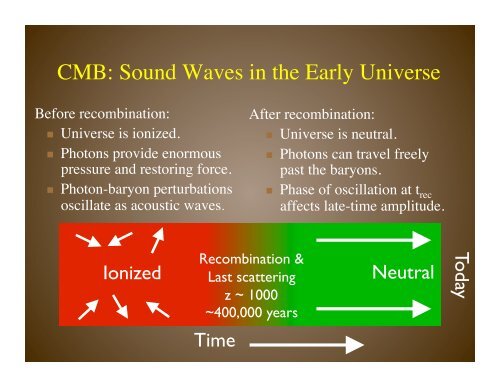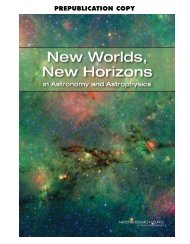CMB: Sound Waves in the Early Universe
CMB: Sound Waves in the Early Universe
CMB: Sound Waves in the Early Universe
Create successful ePaper yourself
Turn your PDF publications into a flip-book with our unique Google optimized e-Paper software.
<strong>CMB</strong>: <strong>Sound</strong> <strong>Waves</strong> <strong>in</strong> <strong>the</strong> <strong>Early</strong> <strong>Universe</strong><br />
Before recomb<strong>in</strong>ation:<br />
<strong>Universe</strong> is ionized. <br />
Photons provide enormous<br />
pressure and restor<strong>in</strong>g force. <br />
Photon-baryon perturbations<br />
oscillate as acoustic waves.<br />
After recomb<strong>in</strong>ation:<br />
<strong>Universe</strong> is neutral.<br />
Photons can travel freely<br />
past <strong>the</strong> baryons.<br />
Phase of oscillation at t rec<br />
affects late-time amplitude.<br />
Ionized<br />
Recomb<strong>in</strong>ation &<br />
Last scatter<strong>in</strong>g<br />
z ~ 1000<br />
~400,000 years<br />
Neutral<br />
Today<br />
Time
Acoustic Oscillations <strong>in</strong> <strong>the</strong> <strong>CMB</strong><br />
Temperature map of<br />
<strong>the</strong> cosmic microwave<br />
background radiation<br />
<br />
Although <strong>the</strong>re are fluctuations on all scales, <strong>the</strong>re is a characteristic angular<br />
scale, ~ 1 degree on <strong>the</strong> sky, set by <strong>the</strong> distance sound waves <strong>in</strong> <strong>the</strong> photonbaryon<br />
fluid can travel just before recomb<strong>in</strong>ation: sound horizon ~ c s t ls
WMAP
<strong>Sound</strong> <strong>Waves</strong><br />
Each <strong>in</strong>itial overdensity (<strong>in</strong> dark<br />
matter & gas) is an overpressure<br />
that launches a spherical sound<br />
wave.<br />
This wave travels outwards at <br />
57% of <strong>the</strong> speed of light.<br />
Pressure-provid<strong>in</strong>g photons<br />
decouple at recomb<strong>in</strong>ation.<br />
<strong>CMB</strong> travels to us from <strong>the</strong>se<br />
spheres.<br />
Eisenste<strong>in</strong>
Standard ruler
<strong>CMB</strong><br />
Hu<br />
Angular scale subtended by s
Geometry of three-dimensional space <br />
K>0 K
s<br />
θ<br />
<strong>CMB</strong> Maps
Angular<br />
positions<br />
of acoustic<br />
peaks<br />
probe<br />
spatial<br />
curvature<br />
of <strong>the</strong><br />
<strong>Universe</strong><br />
Hu<br />
~1/θ
Microwave Background Anisotropy<br />
Probes Spatial Curvature <br />
Boomerang (2001) Netterfield et al <br />
DASI (2001) Pryke et al<br />
Data <strong>in</strong>dicates nearly flat geometry if w =-1
<strong>CMB</strong> Results <br />
WMAP3 Results<br />
assum<strong>in</strong>g w=-1
Assum<strong>in</strong>g k=0<br />
as chang<strong>in</strong>g Ω DE
=1-Ω m
<strong>CMB</strong> shift parameter<br />
<strong>CMB</strong> anisotropy constra<strong>in</strong>t on<br />
Angular Diameter distance to lastscatter<strong>in</strong>g<br />
well approximated by:<br />
R = Ω m<br />
H 0<br />
2<br />
z LS<br />
( ) 1/ 2 dz<br />
∫ =1.715 ± 0.021<br />
H(z)<br />
0<br />
z LS<br />
=1089<br />
WMAP5 results Komatsu etal 2008<br />
€<br />
SALT MLCS<br />
SDSS only:<br />
Nearby+SDSS:<br />
MLCS<br />
w = −0.93± 0.13(stat) +0.10 −0.32<br />
(syst)<br />
SALT<br />
w = −0.92 ± 0.11(stat) +0.07 −0.15<br />
(syst)<br />
18 Ω M
Standard ruler
The Structure Formation Cookbook<br />
1. Initial Conditions: A Theory for <strong>the</strong> Orig<strong>in</strong> of Density <br />
Perturbations <strong>in</strong> <strong>the</strong> <strong>Early</strong> <strong>Universe</strong><br />
P m (k)~k n , n~1<br />
Primordial Inflation: <strong>in</strong>itial spectrum of density perturbations <br />
2. Cook<strong>in</strong>g with Gravity: Grow<strong>in</strong>g Perturbations to Form Structure<br />
Set <strong>the</strong> Oven to Cold (or Hot or Warm) Dark Matter<br />
Season with a few Baryons and add Dark Energy P<br />
m (k)~T(k)k n<br />
3. Let Cool for 13 Billion years <br />
Turn Gas <strong>in</strong>to Stars<br />
<br />
P g (k)~b 2 (k)T(k)k n<br />
4. Tweak (1) and (2) until it tastes like <strong>the</strong> observed <strong>Universe</strong>.
Cold Dark<br />
Matter Models<br />
Power Spectrum <br />
of <strong>the</strong> Mass<br />
Density<br />
( ) = d 3<br />
δ k<br />
∫<br />
δ( k 1 )δ( k 2 ) =<br />
( 2π) 3 P k 1<br />
( )<br />
x ⋅ e i k ⋅x δρ x<br />
ρ<br />
( k 2 )<br />
( )δ <br />
3 k 1<br />
+
Cold Dark Matter<br />
Models<br />
Theoretical<br />
Power Spectrum <br />
of <strong>the</strong> Mass Density<br />
δ k<br />
∫<br />
( ) = d 3<br />
( )<br />
x ⋅ e i k ⋅x δρ x<br />
ρ<br />
P ~ k n <br />
Ω m h =0.2<br />
P ~ k –3 <br />
δ( k 1 )δ( k 2 ) =<br />
( 2π) 3 P k 1<br />
( k 2 )<br />
( )δ <br />
3 k 1<br />
+ <br />
Power spectrum<br />
measurements<br />
probe cosmological<br />
parameters<br />
Ω m h =0.5<br />
k eq ~ Ω m h <br />
L<strong>in</strong>ear<br />
h/Mpc<br />
Non-l<strong>in</strong>ear
<strong>Sound</strong> <strong>Waves</strong> aga<strong>in</strong><br />
<br />
<br />
<br />
<br />
<br />
Each <strong>in</strong>itial overdensity (<strong>in</strong> dark matter &<br />
gas) is an overpressure that launches a<br />
spherical sound wave.<br />
This wave travels outwards at <br />
57% of <strong>the</strong> speed of light.<br />
Pressure-provid<strong>in</strong>g photons decouple at<br />
recomb<strong>in</strong>ation. <strong>CMB</strong> travels to us from<br />
<strong>the</strong>se spheres.<br />
<strong>Sound</strong> speed plummets. Wave stalls at a<br />
radius of 150 Mpc.<br />
Overdensity <strong>in</strong> shell (gas) and <strong>in</strong> <strong>the</strong> orig<strong>in</strong>al<br />
center (DM) both seed <strong>the</strong> formation of<br />
galaxies. Preferred separation of 150 Mpc.<br />
Eisenste<strong>in</strong>
A Statistical Signal<br />
The <strong>Universe</strong> is a superposition<br />
of <strong>the</strong>se shells.<br />
The shell is weaker than<br />
displayed.<br />
Hence, you do not expect to<br />
see bulls’ eyes <strong>in</strong> <strong>the</strong> galaxy<br />
distribution.<br />
Instead, we get a 1% bump<br />
<strong>in</strong> <strong>the</strong> correlation function.
Orig<strong>in</strong> of Baryon Acoustic<br />
Oscillations (BAO)<br />
28
Collision Term<br />
29
sound horizon scale<br />
30
k A =2π/s<br />
32
Simulation<br />
plus Poisson errors: multiply<br />
by (1+1/nP) 2<br />
Assumes Gaussian errors (l<strong>in</strong>ear <strong>the</strong>ory)<br />
Fit with::
Power Spectrum<br />
34
Correlation Function<br />
Measure redshifts<br />
and angular<br />
positions<br />
Convert to<br />
comov<strong>in</strong>g<br />
separation us<strong>in</strong>g<br />
redshift-distance<br />
relation<br />
35
Dependence on w<br />
Tangential<br />
Radial<br />
Assum<strong>in</strong>g<br />
constant<br />
Ω m<br />
Measure<br />
k A to 1%<br />
plus<br />
known s<br />
yields w<br />
to ~5%
SDSS<br />
Galaxy<br />
Distribution<br />
Lum<strong>in</strong>ous<br />
Red<br />
Galaxies<br />
SDSS Galaxy<br />
Distribution
Large-scale Correlations of <br />
SDSS Lum<strong>in</strong>ous Red Galaxies<br />
Redshiftspace<br />
Correlation<br />
Function<br />
ξ(r) =<br />
δ( x )δ( x + r )<br />
Baryon<br />
Acoustic<br />
Oscillations<br />
seen <strong>in</strong><br />
Large-scale<br />
Structure<br />
Warn<strong>in</strong>g:<br />
Correlated<br />
Error Bars<br />
Eisenste<strong>in</strong>, etal
Model Comparison<br />
Fixed Ω b h 2 =0.024<br />
n s =0.98, flat<br />
CDM with baryons is a good fit: χ 2 = 16.1 with 17 dof.<br />
Pure CDM rejected at Δχ 2 = 11.7<br />
Equality scale depends<br />
on (Ω m h 2 ) -1 .<br />
Acoustic scale depends<br />
on (Ω m h 2 ) -0.25 .<br />
Ω m h 2 = 0.12<br />
Ω m h 2 = 0.13<br />
Ω m h 2 = 0.14<br />
Ω b h 2 = 0.00
Constra<strong>in</strong>ts<br />
€<br />
Galaxy pair with separations Δz, Δθ :<br />
Δr c<br />
= cΔz /H(z) radial comov<strong>in</strong>g separation<br />
Δr c<br />
= Δθ(1+ z)d A<br />
angular comov<strong>in</strong>g separation<br />
Spherically averaged correlation<br />
function probes<br />
⎡<br />
D V<br />
(z) = ⎢ (1+ z) 2 d 2 A<br />
(z)<br />
⎣<br />
cz ⎤<br />
⎥<br />
H(z) ⎦<br />
1/ 3<br />
SDSS : D V<br />
(z = 0.35) =1370 ± 64 Mpc<br />
R 0.35<br />
= D V<br />
(0.35) /d A<br />
(z LS<br />
) = 0.0979 ± 0.0036<br />
A = D V<br />
(0.35)<br />
Ω m<br />
H 0<br />
2<br />
0.35c = 0.469 ± 0.017 Eisenste<strong>in</strong> etal 2005<br />
SALT MLCS<br />
SDSS only:<br />
Nearby+SDSS:<br />
MLCS<br />
w = −0.93± 0.13(stat) +0.10 −0.32<br />
(syst)<br />
SALT<br />
w = −0.92 ± 0.11(stat) +0.07 −0.15<br />
(syst)<br />
44 Ω M
BAO from SDSS + 2dFGRS<br />
BAO detected at low redshift<br />
0
Cosmological constra<strong>in</strong>ts: BAO<br />
Consider two simple models:<br />
1. ΛCDM<br />
2. Flat, constant w<br />
Constra<strong>in</strong>t from<br />
D V (0.35)/D V (0.2)<br />
Constra<strong>in</strong>t fitt<strong>in</strong>g s/D V<br />
with model for s<br />
Constra<strong>in</strong>t <strong>in</strong>clud<strong>in</strong>g<br />
distance to <strong>CMB</strong><br />
d A (z LS )/D V<br />
Percival et al. 2007<br />
46
Galaxy Cluster<strong>in</strong>g <br />
varies with Galaxy <br />
Type<br />
How are each of <strong>the</strong>m<br />
related to <strong>the</strong> <br />
underly<strong>in</strong>g Dark<br />
Matter distribution?<br />
BIAS<br />
Caveat for <strong>in</strong>ference<br />
of Cosmological<br />
Parameters from LSS
Galaxy Cluster<strong>in</strong>g as a function of Galaxy Lum<strong>in</strong>osity<br />
bright<br />
fa<strong>in</strong>t<br />
Zehavi, etal<br />
Based on sample of ~200,000 galaxies<br />
Tegmark, etal
δn gal<br />
Correct<br />
For<br />
Lum<strong>in</strong>osity<br />
Bias<br />
Vertical<br />
Shift:<br />
Constant<br />
Bias<br />
n gal<br />
( )<br />
( L)<br />
L, x<br />
= b L<br />
( ) δρ ( x<br />
)<br />
ρ
Systematic Issues for BAO<br />
Effects of non-l<strong>in</strong>earities on BAO signal<br />
Model<strong>in</strong>g redshift distortions precisely<br />
Effects of (non-l<strong>in</strong>ear) galaxy bias<br />
Halos vs. Dark Matter<br />
Real Space<br />
Redshift Space
III. Baryon Acoustic Oscillations<br />
Galaxy Angular<br />
Correlation Function<br />
<strong>in</strong> Photo-z b<strong>in</strong>s<br />
Systematics:<br />
photo-z’s,<br />
correlated<br />
photometric errors,<br />
non-l<strong>in</strong>earity, scaledependent<br />
bias<br />
Fosalba & Gaztanaga<br />
53
III. Baryon Acoustic Oscillations<br />
Blake & Bridle<br />
54
DES Science Program<br />
Four Probes of Dark Energy<br />
• Galaxy Clusters<br />
• ~100,000 clusters to z>1<br />
• ~10,000 with SZE measurements from SPT<br />
• Sensitive to growth of structure and geometry<br />
• Weak Lens<strong>in</strong>g<br />
• Shape measurements of 300 million galaxies <br />
• Sensitive to growth of structure and geometry<br />
• Baryon Acoustic Oscillations<br />
• 300 million galaxies to z = 1 and beyond<br />
• Sensitive to geometry<br />
• Supernovae<br />
• 15 sq deg time-doma<strong>in</strong> survey<br />
• ~3000 well-sampled SNe Ia to z ~1<br />
• Sensitive to geometry<br />
Forecast Constra<strong>in</strong>ts on DE<br />
Equation of State<br />
55
Photometric Redshifts<br />
• Measure relative flux <strong>in</strong><br />
multiple filters:<br />
track <strong>the</strong> 4000 A break<br />
• Estimate <strong>in</strong>dividual galaxy<br />
redshifts with accuracy<br />
σ(z) < 0.1 (~0.02 for clusters)<br />
• Precision is sufficient<br />
for Dark Energy probes,<br />
provided error distributions<br />
well measured.<br />
Elliptical galaxy spectrum<br />
56
Galaxy Photo-z Simulations<br />
DES +VHS*<br />
10σ Limit<strong>in</strong>g Magnitudes<br />
g 24.6<br />
r 24.1 J 20.3<br />
i 24.0 H 19.4<br />
Z z 23.8 23.9 Ks 18.3<br />
Y 21.6<br />
+2% photometric calibration<br />
error added <strong>in</strong> quadrature<br />
Photo-z systematic errors<br />
under control us<strong>in</strong>g exist<strong>in</strong>g<br />
spectroscopic tra<strong>in</strong><strong>in</strong>g sets to<br />
DES photometric depth: low-risk<br />
DES griz griZY<br />
+VHS JHKs on<br />
ESO VISTA 4-m<br />
enhances science<br />
reach<br />
*Vista Hemisphere Survey<br />
+Developed improved Photo-z & Error Estimates and robust methods of outlier rejection<br />
57<br />
Oyaizu, Cunha, Lima, Frieman, L<strong>in</strong>

















